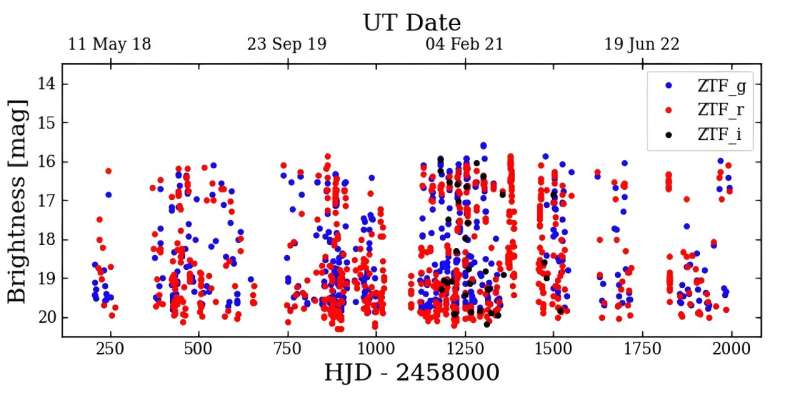August 16, 2023 report
This article has been reviewed according to Science X's editorial process and policies. Editors have highlighted the following attributes while ensuring the content's credibility:
fact-checked
preprint
trusted source
proofread
New asynchronous polar discovered with Zwicky Transient Facility

Using the Zwicky Transient Facility (ZTF), Russian astronomers have investigated a cataclysmic variable (CV) system of the polar subtype known as SDSS J085414.02+390537.3 (or J0854 for short). They found that J0854 belongs to a rare class of CVs, dubbed asynchronous polars. The discovery was detailed in a paper published August 8 on the pre-print server arXiv.
CVs are binary star systems consisting of a white dwarf accreting material from a normal star companion. They irregularly increase in brightness by a large factor, then drop back down to a quiescent state. Polars are a subclass of cataclysmic variables distinguished from other CVs by the presence of a very strong magnetic field in their white dwarfs.
Some polars are asynchronous—exhibiting a weak asynchrony not exceeding a few percent. It is assumed that such polars are asynchronous as a result of a recent nova explosion. Observations suggest that the asynchronous state is unstable and these systems move towards a state of synchronous motion. To date only a few polars of this class have been identified.
Now, a team of astronomers led by Alexander Kolbin of the Special Astrophysical Observatory (SAO) in Russia, report the detection of the news addition to the short list of known asynchronous polars. They found that the polar J0854 showcases asynchrony in the long-term light curves of the ZTF survey.
"The asynchrony of the polar SDSS J085414.02+390537.3 was revealed using the data of ZTF photometric survey," the researchers wrote in the paper.
By analyzing the ZTF light curve of J0854, the team identified a beat period of approximately 24.6 days and orbital period of about 113.56 days. During the beat period, the system showcases brightness variability typical for the change in the states of the polars due to the variability of the accretion rate.
The asynchrony of J0854 was estimated to be approximately 0.3%. This result is consistent with the values for other known asynchronous polars as they exhibit asynchrony not exceeding 2%.
Furthermore, the astronomers calculated the magnetic field of the white dwarf in J0854. The obtained result, based on the Zeeman splitting of the Hβ line, is 28.5 MG. However, by modeling cyclotron spectra, the magnetic field strength near the magnetic pole was found to be about 34 MG.
Summing up the results, the authors of the paper noted that J0854 is an interesting object for further optical observations. They propose polarization observations in different phases of the beat period in order to test the hypothesis of switching between the main accreting poles.
"When accretion changes from one pole to another, one should expect a change in the sign of circular polarization. It would be interesting to carry out additional phase-resolved spectral observations. The corresponding Doppler maps would make it possible to study changes in the geometry of accretion flows during the rotation of the magnetic dipole relative to the donor," the researchers concluded.
More information: A. I. Kolbin et al, SDSS J085414.02+390537.3—a new asynchronous polar, arXiv (2023). DOI: 10.48550/arxiv.2308.04597
Journal information: arXiv
© 2023 Science X Network





















